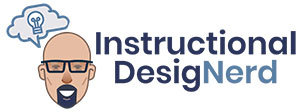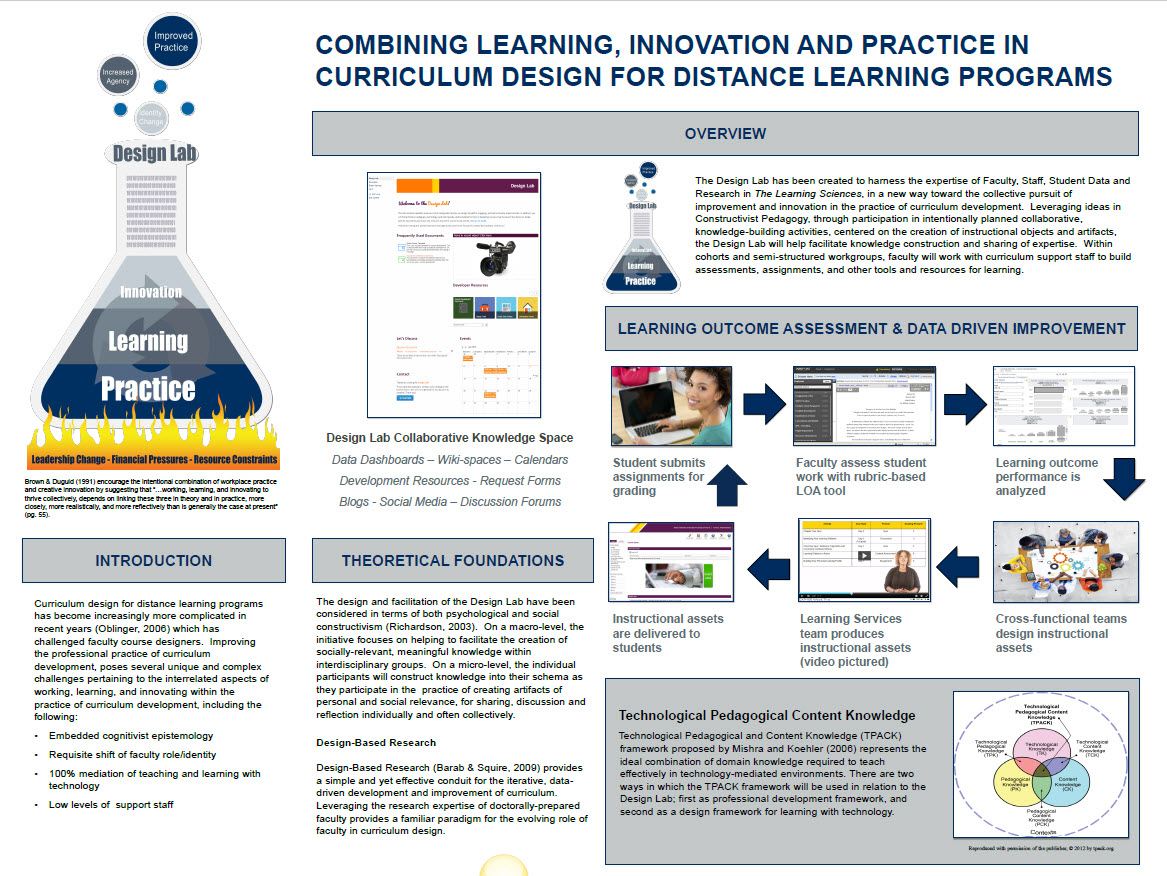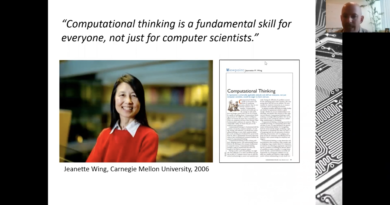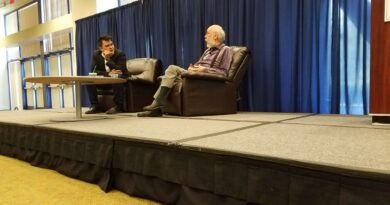Design Lab: Combining Learning, Innovation and Practice in Curriculum Design for Distance Learning Programs
Learning and Identity Change:
The implementation and success of the Design Lab will depend in part on the successful management of identity change of throughout the life of the project. Virtually all participants will be engaging in new activities in which their identities will be socially constructed and evolve through changes in practice, shifts in organizational structure and an increased expectation of innovativeness. The connections between learning and identity have been long considered in the work of (Lave & Wenger 1991, Brown 2001, Wenger 2015), and the psychological and emotional implications of such have long been ignored by practitioners of curriculum design. Lave & Wenger (1991) argue that “…learning and a sense of identity are inseparable: They are aspects of the same phenomenon.”(loc. 1321)
Learning and identity in the workplace are also tightly connected in the literature but ignored in practice. Brown and Duguid, (2001) argue that learning “… doesn’t just involve the acquisition of facts about the world, it also involves acquiring the ability to act in the world in socially recognized ways.” (pg. 200) As faculty in particular experience a shift in their job expectations pertaining to curriculum development in the process of engaging in new activities in social contexts with other faculty and experts in different domains, identity management will be an important consideration. Wenger (2015) argues for more than just consideration, but support when he writes, “If learning is not just about ‘learning to do’ but is also, importantly, about ‘learning to be’ then those who have a role in supporting learning need to pay explicit attention to supporting identity work.” (loc. 935) With this in mind, special attention will be paid to the transition of the identities of the various stakeholder groups in the several ways outlined below.
Of particular consideration will be the identity of the faculty and the expectation that they apply their research experience and expertise to the issues of student success and curriculum quality. Through work in the design lab, Faculty become more powerful in their ability to impact students through the increased access to curriculum-building tools and expertise, collaborative workshops and other application of practice with the communities and groups which have been self-organized around their individual practices.
Faculty will be required to use data to inform their decision making process and provide a rationale. It will be up to faculty to select from a variety of tried and true research methods from quantitative, to qualitative and mixed methods as well. While some questions will best be answered in terms of the experimental and quasi-experimental research design (Creswell, 2012), surely others will lend themselves to more of a phenomenological, ethnographic, or grounded theory approach.
As a way of tying the previous experiences and existing identities of faculty as creators of knowledge within their domain of practice the promotion of innovation in curriculum development, will be tied explicitly to the Design-Based Research methodology as described in Barab & Squire, (2009). Developed in the early 1990’s by Anne Brown, design-based research provides a simple and yet effective paradigm for the data-driven iterative development and improvement of curriculum. The utilization of the DBR framework is basis for the moniker Design Lab, and has continued to be a significant component of the vision of the Design Lab itself. The complex and multifaceted nature of the Design Lab makes it somewhat difficult to describe, but using the metaphor of the curriculum laboratory, provides a culturally relevant reference, to an existing schema that helps transmit the vision and identity of the project.
Overcoming Challenges with Technology
In order to inform the effort to integrate workplace learning (in this case, faculty professional development) into practice and innovation, literature on professional development theory and practice will be considered, with particular attention paid to the idea of combined expertise and requisite domains of knowledge required to designing learning experiences. The work of Lee S. Shulman will be briefly discussed and offered as a foundation for a more complex discussion of domain expertise required for constructing meaningful learning experiences at Online University in particular.
Nearly thirty years ago now, Shulman argued that effective teaching and learning was a fundamentally a result of the combination of two distinct types of domain knowledge when he Introduced the term and the concept of Pedagogical Content Knowledge (PCK) to the conversations surrounding developing well prepared and effective teachers. Good teaching, he argued depended upon the meaningful and synergistic combination of Content Knowledge from ones’ domain of subject matter expertise, with knowledge of Pedagogical practices that support learning. Simply put by Shulman (1987) himself, “…teaching necessarily begins with a teacher’s understanding of what is to be learned and how it is to be taught.” (pg. 7)
While there has been little resistance or argument against the idea that the two most significant characteristics for success in teaching and learning are a combination of Pedagogical and Content Knowledge in a traditional classroom environment, the online environment requires additional considerations, that many educators have yet to consider. As a result, the Technological Pedagogical and Content Knowledge (TPACK) framework proposed by Mishra and Koehler (2006) will be a foundational element in the design and implementation of the OU Design Lab. The addition of the Technological Knowledge domain to Schulman’s Pedagogical Content Knowledge provides a more powerful lens to the design and facilitation effective teaching and learning completely mediated by technology (see Figure 2.1).
Figure 2.1, Technical Pedagogical and Content Knowledge domain diagram
Figure 2.1 shows the interrelationship of the knowledge domains that help form the TPACK framework. At the intersection of the three domains of knowledge lies complex, situated form of knowledge that Mishra and Koehler (2006) refer to as Technical Pedagogical Content Knowledge, which represents the ideal combination of domains of knowledge to be able to teach content in technology and media based environments.
There are two ways in which the TPACK framework will be used in relation to the OU Design Lab; first as professional development framework, and second as a design framework for learning with technology. As an explicit Professional Development framework, TPACK allows for new conversations with faculty and about faculty professional development in ways the acknowledge and validate their content knowledge while simultaneously acknowledging the additional domains of knowledge required to engage in effective design of learning experiences. This will be particularly important as collaborators representing domain knowledge areas outside of the faculty member’s expertise contribute to the design of the course which is historically the faculty member’s purview alone. Recognizing the need for additional expertise helps to form a base for collaboration between the variety of experts involved in the process.
Equally as important as providing a new way to view the expertise required in facilitating learning online, is the specific focus on technology that TPACK provides which allows for new ways to think about leveraging technology for learning. As more and more educational institutions offer curriculum online, more and more, designers and educators like those at OU, are expected to leverage technology for purpose of learning. With a vast proliferation of tools and opinions about their affordances, it has become even more important to critically analyze the ways in which technology impacts learning.
The importance of thoughtfully considering the mediation of learning through technology becomes more apparent when analyzed to through the lens of critical author and philosopher of media and communications, Marshall McLuhan. McLuhan (1964) argued compellingly that “The Medium is the Message”, highlighting the inextricable relationship between a given medium and the intended message it is intended to deliver. Historically, many courses and assignments at Online University have been designed with little to no specific consideration of affordances of the medium can be intentionally leveraged the in relation to the intent of the message, resulting in ineffective and sometimes counterproductive implementations of technology.
The impact of technology on creating and delivering learning experiences cannot be overestimated at Online University, given that the large majority of OU students experience the nearly all of their learning within the Learning Management System. Online University uses Pearson’s Learning Studio, which like many learning management systems (LMS), is a password-protected environment, in which academic courses and content are delivered by the university, facilitated by faculty, and engaged in by students. This virtual space is largely where formal assessments are completed, compliance-related attendance and identity information captured and verified, and not the least of which, where student learning is expected to take place.
The LMS is the medium, what is the message?
Conceived upon the aforementioned assumptions of the practices of the cognitivist learning theories, LMSs, have historically been designed like traditional classrooms, based on the goal of separating the learner from the distractions of the world, and promoting focus on the teaching and narrative of the instructor. The very issues that Wenger (1999) pointed out related to traditional classrooms have arguably been reproduced in the virtual-world through the widespread adoption of the LMS/VLE model. Students are still largely forced to demonstrate their knowledge out of context through conversations with other novices talking about and describing what they perceive the practice of subject to be, but hardly if ever engaging in in the practice directly. Assessments are largely unauthentic and abstract, not only providing a poor measure of learning of value but leading students to become frustrated and bored. The same problems that plague very students of Online University students in their struggle for success in institutionally designed environments, are the very same problems that plague professional development efforts for the faculty who participate in curriculum development.
As a starting point for the Design Lab initiative, all resources and content on the designated web-space will be constructed and curated by teams of internal stakeholders, and shared publicly for discussion and meaning-making. Unlike the traditional LMS mediated learning experience, faculty and staff will utilize a combination of tools including Google Drive, Hangouts, and other collaborative tools, wikis, blogs and discussion through social media that will allow participants to construct their own understandings and share with the group for collective discussion and evaluation. The importance of aligning the technology tools with their intended function cannot be overstated, and is a significant consideration in the design of curriculum assets, as well as the Design Lab itself.




